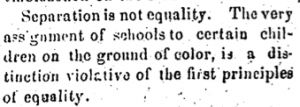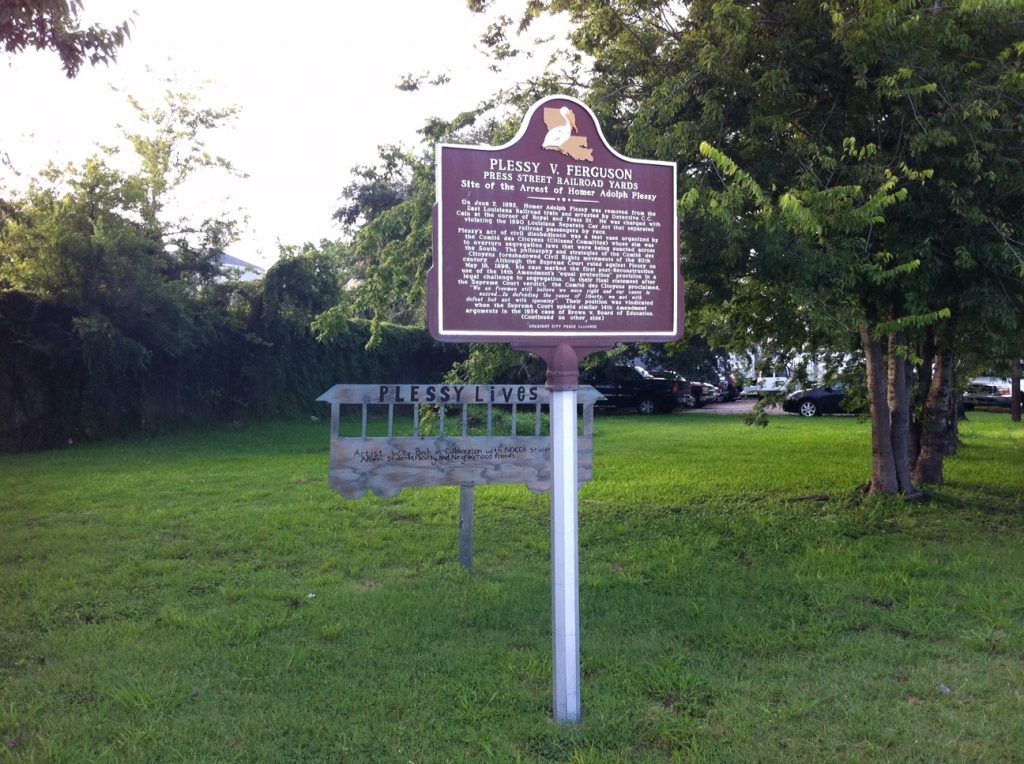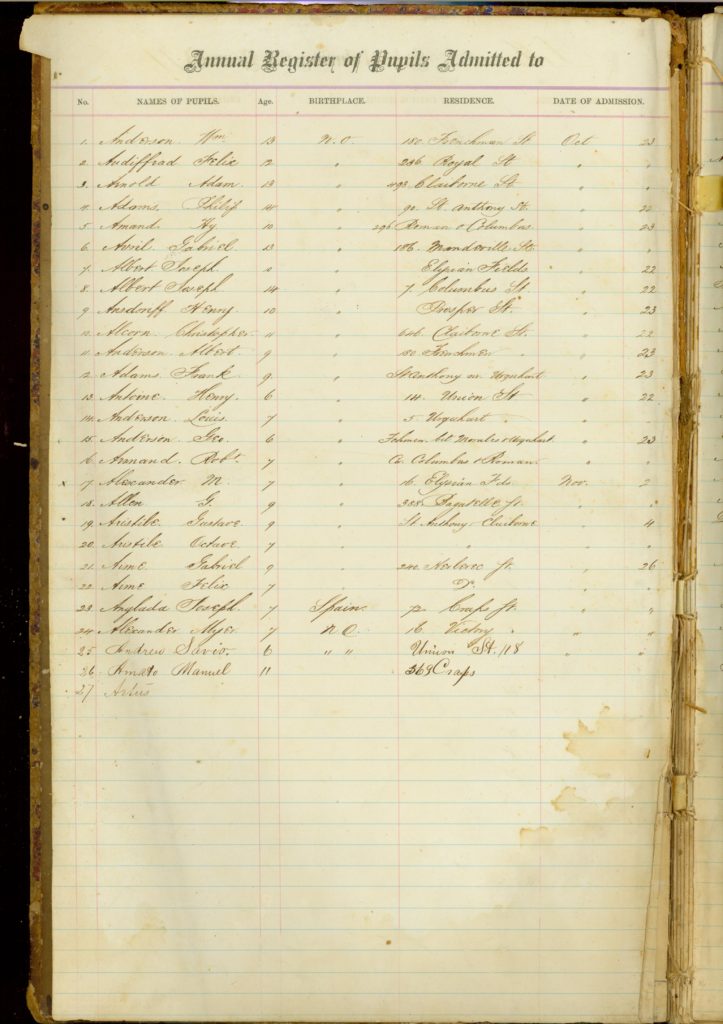School Desegregation in Reconstruction New Orleans
The New Orleans public school system was one of the oldest in the American South. Established in 1841, all the schools were exclusive to white children. Black New Orleanians, whether free or enslaved, were forbidden to attend public schools.
Access to Public Education
The Union occupation of New Orleans in May 1862 created a new opportunity for African Americans to shape and pursue their visions of freedom. Black New Orleanians, both Creoles and Anglophone communities, regarded right to education as a fundamental tenet of civil rights. Notably, they did not only demand access to public education, but also argued that their children should be able to attend any school with whites. They pushed the desegregation of public schools by joining the Republican Party, forming numerous social and cultural clubs and organizations, and advocating for their ideals in newspapers such as L’Union and the New Orleans Tribune.
The 1868 State Constitution
After long years of grassroots activism, Black political leaders attended the state constitutional convention for the first time ever in 1867. Their participation drastically changed state laws. The 1868 Louisiana state constitution not only assured children of African descent the right to public education, but also banned the establishment of segregated public schools.
Desegregation in the 1870s
Even after the ratification of the 1868 state constitution, many whites including New Orleans school board members attempted to maintain schools exclusively for white children. After three years of political debates at the state legislature, a number of court cases, and individual admission requests, the radical Republicans, led by African American leaders, took over the school board in 1871. Under their guidance, white schools accepted the admission of African American students upon the request of families who wished to send their children to a white school.
From 1871 to 1877, about one-third of the city public schools admitted both white and African American students, until the city school board became a majority-segregationist group again and decided to resegregate every school in the city.
Creoles of Color
The major contributor to school desegregation in New Orleans was the community of Creoles of color, also known as gens de couleur libre (free people of color). They were members of the Creole population in Louisiana, a diverse group of people rooted in colonial Louisiana, French colonies in the Caribbean, Africa, and Europe. Creoles of color were situated in a distinct status, in-between free whites and enslaved people in the ante-bellum period, due to their interracial heritage and free status.
Creoles of color in the Civil War and Reconstruction

Excerpt from “Star School,” New Orleans Tribune, May 12, 1867.
During and the immediately after the Civil War, Creoles of color in New Orleans began expressing their demand for racial desegregation through their newspaper, L’Union and the New Orleans Tribune. They regarded equal access to public facilities as an essential part of civil rights. Creoles of color put a particular emphasis on the desegregation of public schools. In forging school desegregation, they created an interracial and ethnic alliance with white radicals and Anglophone Blacks in the Republican Party. Creoles of color contributed to legalize desegregation and negotiated with white school principals who tried to maintain segregation.
School Desegregation in the 1870s
Throughout the 1870s, Creoles of color supported the desegregation of public schools despite severe criticism and resistance from many white New Orleanians. More than half of the desegregated schools were located downriver of New Orleans in historically francophone neighborhoods.
In 1877, when the city school board decided to resegregate every public schools in New Orleans, Creoles of color petitioned the governor of Louisiana for relief, filed consecutive lawsuits against the school board, and held numerous meetings among the Black population in New Orleans to halt segregation. Although much of these efforts failed, the resistance against school segregation continued onward.
Plessy v. Ferguson
Plessy v. Ferguson Historic Marker (June 2013, photo taken by author)

The efforts of Creoles of color to desegregate public institutions persisted and expanded in various public spheres toward the end of the nineteenth century. Their commitment culminated in Plessy v. Ferguson, the Supreme Court case of 1896. In this court case, Homer A. Plessy and the Citizens’ Committee appealed the unconstitutionality of the 1890 Louisiana railroad segregation act, also known as “the separate car act.” Although they lost the case and Jim Crow became the law of the land, the case was the climax of their forty years of commitment to racial equality in the late nineteenth century.
The Fillmore School
Overview
The Fillmore Boys School was one of the desegregated schools in Reconstruction New Orleans. It was located on Pauger St. between Marais St. and St. Claude Ave. (around 1812 Pauger St.), in the New Marigny neighborhood, one of the predominantly and historically Creole neighborhoods in downriver New Orleans. The school was officially categorized as a grammar A school that consists both grammar and primary level classes. Grammar A schools were gateways to high schools. In each year of Reconstruction, the Fillmore School recorded some students who passed the high school entrance exams. The Fillmore School was desegregated in 1871.
The Fillmore School ca. 1900s (renamed McDonogh No. 16 in 1884.) Courtesy of the New Orleans Public Library

The School Register
The Fillmore Boys School’s 1877 register is part of the Orleans Parish School Board Collection of the Earl K. Long Library Special Collections at the University of New Orleans. This record is the city’s oldest individual school record remaining from the 1870s. The register contains a student admission list that shows students’ name, age, birthplace, address, admission date, parent’s name, and occupation. The register contains 658 student data entries. However the school principal reported the number of actual attendance was 484 during the 1877-1878 school year.

Many New Orleans Reconstruction school records do not have any racial information. Likewise, the Fillmore School admission list does not contain students’ racial information. However, some students were recorded as “transferred to colored school” in the list. It was due to the resegregation decision made by the school board in July in the same year. The Fillmore School was a white school again in 1877. The list poses some very interesting question. Why are there students of African descent in the 1877 admission list?
While white students were children of French, German, Irish or Italian descents, most of the ‘non-white’ students were children of Creoles of color. The Fillmore Boys School demonstrates the strong commitment to desegregated education among them. From 1877 to 1879, the Fillmore Boys School served as a legal battleground for the three parents of Creoles of color who insisted upon the unconstitutionality of school resegregation. The list also shows the complex racial identities and characteristics among Creoles of color, as some of them are not noted as “transferred to colored school.”
All in all, the Fillmore School list offers an insight into desegregation and anti-segregation experiences among Creoles of color at the end of Reconstruction at a granular level.
The Fillmore School after 1878: McDonogh No. 16
The Fillmore School continued to be designated as a white school and it became a school for both boys and girls in 1880. In 1884, the school was supported by the McDonogh Fund, the educational fund established by the will of John McDonogh, and renamed McDonogh No. 16 School. In 1908, the city school board bought lots adjacent to the original school site and remodeled the school building. Without the original building or name, the Fillmore School and its desegregation struggle was forgotten.
The Civil Rights Movement

The McDonogh No. 16 School Building (June 2014, photo taken by author)
After the Brown v. Board of Education and Bush v. Orleans Parish School Board court cases, the McDonogh No. 16 School once again admitted Black children in 1962 onward. The enrollment of Black students steadily increased while concurrently, the number of white students decreased. In fewer than five years, McDonogh No. 16 became a majority Black school.
The McDonogh No. 16 School closed on October 27, 1978 due to decreased enrollment and the financial crisis of the school system. For a time, the school building was used for adult education. In 2005, the school building was closed due to the destruction brought by Hurricane Katrina. In 2011, the school board sold the lot and the building is currently being remodeled as a condominium.